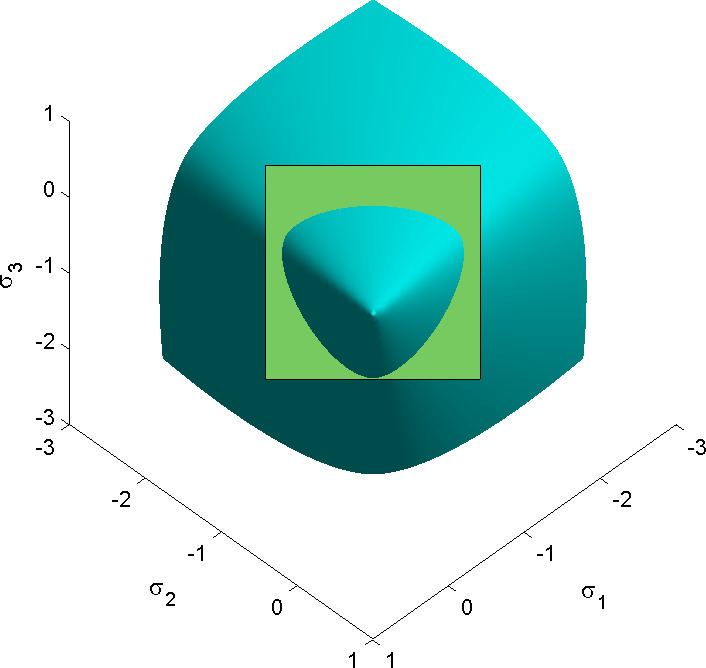The Willam-Warnke yield criterion is a function that is used to predict when failure will occur in concrete and other cohesive-frictional materials such as rock, soil, and ceramics. This yield criterion has the functional form
f
(
I
1
,
J
2
,
J
3
)
=
0
where
I
1
is the first invariant of the Cauchy stress tensor, and
J
2
,
J
3
are the second and third invariants of the deviatoric part of the Cauchy stress tensor. There are three material parameters (
σ
c
- the uniaxial compressive strength,
σ
t
- the uniaxial tensile strength,
σ
b
- the equibiaxial compressive strength) that have to be determined before the Willam-Warnke yield criterion may be applied to predict failure.
In terms of
I
1
,
J
2
,
J
3
, the Willam-Warnke yield criterion can be expressed as
f
:=
J
2
+
λ
(
J
2
,
J
3
)
(
I
1
3
−
B
)
=
0
where
λ
is a function that depends on
J
2
,
J
3
and the three material parameters and
B
depends only on the material parameters. The function
λ
can be interpreted as the friction angle which depends on the Lode angle (
θ
). The quantity
B
is interpreted as a cohesion pressure. The Willam-Warnke yield criterion may therefore be viewed as a combination of the Mohr-Coulomb and the Drucker-Prager yield criteria.
In the original paper, the three-parameter Willam-Warnke yield function was expressed as
f
:=
1
3
z
I
1
σ
c
+
2
5
1
r
(
θ
)
J
2
σ
c
−
1
≤
0
where
I
1
is the first invariant of the stress tensor,
J
2
is the second invariant of the deviatoric part of the stress tensor,
σ
c
is the yield stress in uniaxial compression, and
θ
is the Lode angle given by
θ
=
1
3
cos
−
1
(
3
3
2
J
3
J
2
3
/
2
)
.
The locus of the boundary of the stress surface in the deviatoric stress plane is expressed in polar coordinates by the quantity
r
(
θ
)
which is given by
r
(
θ
)
:=
u
(
θ
)
+
v
(
θ
)
w
(
θ
)
where
u
(
θ
)
:=
2
r
c
(
r
c
2
−
r
t
2
)
cos
θ
v
(
θ
)
:=
r
c
(
2
r
t
−
r
c
)
4
(
r
c
2
−
r
t
2
)
cos
2
θ
+
5
r
t
2
−
4
r
t
r
c
w
(
θ
)
:=
4
(
r
c
2
−
r
t
2
)
cos
2
θ
+
(
r
c
−
2
r
t
)
2
The quantities
r
t
and
r
c
describe the position vectors at the locations
θ
=
0
∘
,
60
∘
and can be expressed in terms of
σ
c
,
σ
b
,
σ
t
as
r
c
:=
6
5
[
σ
b
σ
t
3
σ
b
σ
t
+
σ
c
(
σ
b
−
σ
t
)
]
;
r
t
:=
6
5
[
σ
b
σ
t
σ
c
(
2
σ
b
+
σ
t
)
]
The parameter
z
in the model is given by
z
:=
σ
b
σ
t
σ
c
(
σ
b
−
σ
t
)
.
The Haigh-Westergaard representation of the Willam-Warnke yield condition can be written as
f
(
ξ
,
ρ
,
θ
)
=
0
≡
f
:=
λ
¯
(
θ
)
ρ
+
B
¯
ξ
−
σ
c
≤
0
where
B
¯
:=
1
3
z
;
λ
¯
:=
1
5
r
(
θ
)
.
An alternative form of the Willam-Warnke yield criterion in Haigh-Westergaard coordinates is the Ulm-Coussy-Bazant form:
f
(
ξ
,
ρ
,
θ
)
=
0
or
f
:=
ρ
+
λ
¯
(
θ
)
(
ξ
−
B
¯
)
=
0
where
λ
¯
:=
2
3
u
(
θ
)
+
v
(
θ
)
w
(
θ
)
;
B
¯
:=
1
3
[
σ
b
σ
t
σ
b
−
σ
t
]
and
r
t
:=
3
(
σ
b
−
σ
t
)
2
σ
b
−
σ
t
r
c
:=
3
σ
c
(
σ
b
−
σ
t
)
(
σ
c
+
σ
t
)
σ
b
−
σ
c
σ
t
The quantities
r
c
,
r
t
are interpreted as friction coefficients. For the yield surface to be convex, the Willam-Warnke yield criterion requires that
2
r
t
≥
r
c
≥
r
t
/
2
and
0
≤
θ
≤
π
3
.

